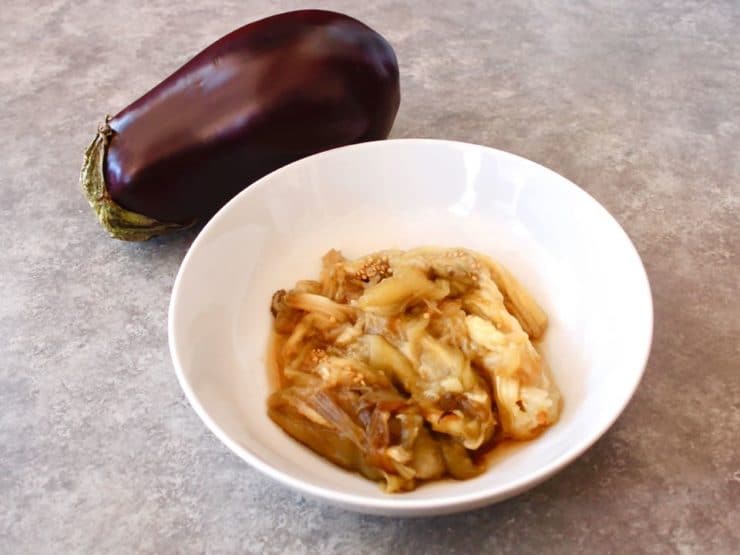How to Roast Eggplant
5.0
(21)
Your folders
Your folders
Prep Time: 2 minutes
Cook Time: 20 minutes
Total: 22 minutes
Servings: 4
Cost: $5.38 /serving
Author : Tori Avey

Ingredients
Export 2 ingredients for grocery delivery
Instructions
Step 1
Wash and dry eggplant. Pierce it a few times with a fork to vent. Important - for any of the cooking methods outlined below, make sure you pierce with a fork-- otherwise you could end up with an exploded eggplant!
Step 2
If you have a gas range, you can roast it directly on top of the range. You might wish to protect your gas range burner with a layer of foil, which makes for easier cleanup. The eggplant will weep a bit as it roasts, leaving charred bits and goop on the range.
Step 3
Place eggplant directly on top of the gas range grate. On my gas stove, I usually turn the flame to medium.
Step 4
Allow eggplant to roast over the flame for 20-30 minutes, giving it a quarter every 5 minutes as it cooks. The larger the eggplant, the longer it will take to roast. Smaller eggplants (like Japanese eggplants) will roast faster. When finished cooking, remove from oven and proceed to "Peeling Your Eggplant."
Step 5
If you have an electric range, or if you want to protect your gas range from the mess, you can use a grill pan to roast the eggplant. A grill pan will protect your stove from the drips of roasted eggplant juice. Here is the one I use - Grill Pan.
Step 6
Prepare grill pan according to instructions. My pan requires a bit of water to be placed in the circular chamber. Preheat grill pan over medium heat; brush lightly with oil if it is recommended for your pan. Pierce the eggplant a few times to vent, then place on the preheated grill pan.
Step 7
Roast the eggplant for 40-50 minutes, giving a quarter turn with a pair of tongs every 5 minutes or so, until the eggplant is charred and collapsing. Check water level about halfway through cooking if your grill pan requires it. When eggplant is tender, charred and collapsing, remove from grill pan and proceed to "Peeling Your Roasted Eggplant."
Step 8
If using a grill, light gas or coals and preheat the grill to medium heat before you begin to roast.
Step 9
Allow eggplant to roast over the flame for 20-30 minutes, giving it a quarter every 5 minutes as it cooks. The larger the eggplant, the longer it will take to roast.
Step 10
When eggplant is tender and collapsing, remove from grill and proceed to "Peeling Your Roasted Eggplant."
Step 11
Place a rack 8-9 inches beneath your oven's broiler and preheat the broiler. Lightly grease a baking sheet with cooking oil. Wash and dry eggplant, then pierce a few times with a fork to vent. Place on a baking sheet under the broiler and let the eggplant roast for 20-30 minutes, giving a quarter turn every 5-7 minutes.
Step 12
Eggplant is finished roasting when it is soft, tender and collapsing. Remove from oven and proceed to "Peeling Your Roasted Eggplant."
Step 13
If you encounter a bitter eggplant, you will want to halve it and salt it prior to cooking. The method for salting is described below. Once salting is complete, this is the way you roast it. Place eggplant halves flesh-side down on a lightly greased baking sheet (so the flat cut side is directly against the baking sheet).
Step 14
Roast 8-9 inches underneath the broiler for 20-30 minutes until the eggplant halves are charred and the halves are beginning to collapse. The larger the eggplant, the longer it will take to roast. Smaller eggplants (like Japanese eggplants) will roast faster. Remove from oven. Check the eggplant flesh to make sure it is soft, roasted, and caramelized throughout. If any parts looked light-colored or undercooked, return to the oven to roast for a few minutes longer.
Step 15
Scoop out the roasted pulpy flesh from each half and place it in a bowl. Discard the charred skin. There will be some residual smoky juice that collects in the bowl; you can drain it off or blend it into the eggplant, depending on the flavor you want to achieve (see Eggplant Roasting Tips, below).
Step 16
Once the eggplant is very tender and collapsing, remove from heat with tongs and place it on a cutting board. There will be some residual smoky juice that collects on the board; you can drain it off or blend it into the eggplant, depending on the flavor you want to achieve.
Step 17
Slice the eggplant open. Scoop out the roasted pulpy flesh and place it in a bowl. Discard the charred skin. The eggplant will be quite soft, and you may need to peel off a few small bits of skin by hand. I'm not super careful about it; I find that a few charred bits actually enhance the smoky flavor, which we find desirable.
Step 18
Once the eggplant is separated from the charred skin, you are left with perfectly tender, roasted and smoky eggplant flesh, which can be used to make baba ghanoush or a variety of purees and dips.